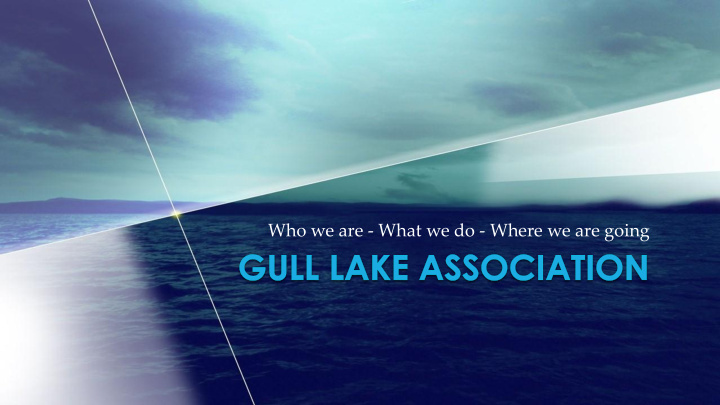



Who we are - What we do - Where we are going
Gull Lake Association Who We Are What We Do Where We Are Going - Challenges
Images
Images
Images
Who We Are Gull Lake Association was incorporated September 29, 1921 Current Gull Lake Association Board • President – Bill English • Vice President – Roger Turner • Secretary – Char Longman • Treasurer – Rick Shields • Member-at-Large – Jeff Price Mission: To Maintain & Operate Gull Lake Dam #565
What We Do Goal: To maintain historical lake levels Check weather forecasts to ensure a timely/appropriate response Adjust dam seasonally (summer vs winter settings) Maintain dam and dam property grounds (access & control) Conduct dam safety inspection @ 5 years • Required Dam Safety, Natural Resources and Environmental Protection Act, Act 451 of 1994) • By qualified engineer e.g. Prein & Newhof
What We Do Plan for capital improvements as appropriate Report annually to GLA members Convene annual meeting Issue shares of stock • One share for each 50 feet, or fraction thereof, of lake frontage Collect annual membership dues • Based on number of shares owned
Where We Are Going - Challenges 2018 Dam Safety Inspection and Useable Dam Life Assessment • The dam is in fair condition and while hazards presenting concern for immediate failure were not observed, the dam’s condition has deteriorated and the GLA has identified a need to plan for rehabilitation or replacement • Dam constructed in 1880, repairs in 1921, minor repairs thereafter • The useful life based on the structural, mechanical, and hydraulic components of the dam & the overall safety of the dam • Typically assume that concrete and earthen components of a dam will last 50- 100 years depending on construction materials and methods
Where We Are Going - Challenges • Physical and mechanical processes such as cracking due to freezing and thawing or wetting and drying cycles • With repair, these components may last an additional 10-20 years. Other portions of the dam, such as the right downstream abutment wall, have deteriorated beyond repair and are assumed to be at their useful life • Chemical processes such as oxidation of metal components within the gate house • Biological processes such as growth of plants in cracks
Where We Are Going - Challenges • Seepage under the foundation or through the embankment. Seepage was observed and will continue to progress and increase the uplift pressure on the wall and toe over time and increasing the risk for failure • We believe the embankment has reached its useful life & the dam is nearing the end of its useful life • Assuming no catastrophic failure occurs, we estimate the remaining useful life of the dam to be 10-20 years.
Where We Are Going - Challenges Repairs – Address minor deficiencies of specific components • Concrete repair using patching, pressure grouting, removing deteriorated concrete, inserting dowels, and forming new concrete on top of the existing concrete feature is likely to extend the useful life of the existing concrete features for another 10-20 years. • Embankment limited due to the presence of a longitudinal seepage plane along the sides of the spillway. Installation of a bentonite slurry wall or a vinyl or steel sheet pile wall could act as a cutoff wall but would require excavating a portion of the embankment to secure it to the spillway wall.
Where We Are Going - Challenges Dam Replacement • Concrete Ogee Spillway - An ogee (or S-shaped) spillway is considered the most hydraulically efficient spillway as the shape generally matches the shape of water falling freely and smoothly transitions falling water into the tailrace • Steel Sheetpile Drop Structure - The spillway could also be constructed solely as a drop or free-flowing structure out of steel sheetpile.
Where We Are Going - Challenges Recommendation - Removal of the old mill foundation wall and spillway, regrading the downstream slope of the east embankment, and installation of a steel sheet pile spillway with stop logs. This alternative is preferred since it is more cost-effective and has fewer long term risks for failure
Where We Are Going - Challenges Estimated Timeline • Fall to Winter – Complete topographical survey, soil borings and geotechnical analysis, and engineering design • Late Winter to Early Spring – Submit permit to the MDEQ • Summer – Bid Project and submit soil erosion and sedimentation control permit to the County Enforcing Agency • From Labor Day to Early Fall – Begin construction on earth embankment & complete earth work with enough time to establish vegetation on east and west embankments. • Fall to Winter – Construct Spillway • Spring – Restore site
Where We Are Going - Challenges Funding Dam Rehabilitation • Michigan Department of Natural Resources (MDNR) Dam Management Grant up to $350,000 for dam repair, rehabilitation, or removal (Grantee - 10% matching) • National Dam Rehabilitation Program Act - grant program to assist local communities with dam repair, rehabilitation, or removal of high hazard dams (Gull Lake dam is classified low hazard) • Bonds, donations, and fees to lake residents may also be used to fund the project
Where We Are Going - Challenges
Where We Are Going - Challenges Want to participate in the GLA? Speak with a GLA Board Member
Thank you for listening!
Recommend
More recommend